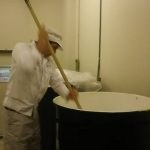BLOG
Yeast Starter Mix
2018.02.22
Sake brewing has a couple of watershed moments. One, for example, is when the Koji takes root in the steamed rice, and comes to life, beginning the process of changing rice starch into sugar.

The other is when we make our first mixture. In our last post, we talked about the Sokujo method of making a starter mix. Now, we wait. We will check on it every day. But there’s a lot more than waiting to be done. This step includes daily checks of acidity, stirring, temperature adjustment and any other care that may be necessary. It’s also the point at which the sake brewing is most vulnerable. Just to enter the room where the starter mix is housed, we need to wash our hands and change our shirts.

When this mash is ready, we can pump it through a hose into a larger tank. At that point, we can add precisely calculated amounts of water and rice and malted koji rice in with the starter mash at intervals, and the fermentation process will continue. It still needs to be carefully watched and adjusted daily, but generally speaking, if the starter mash is good, the full tank of sake will be good. That’s why this is the most sensitive part of the sake making process.
Getting excited about fresh sake yet?
-Jarom